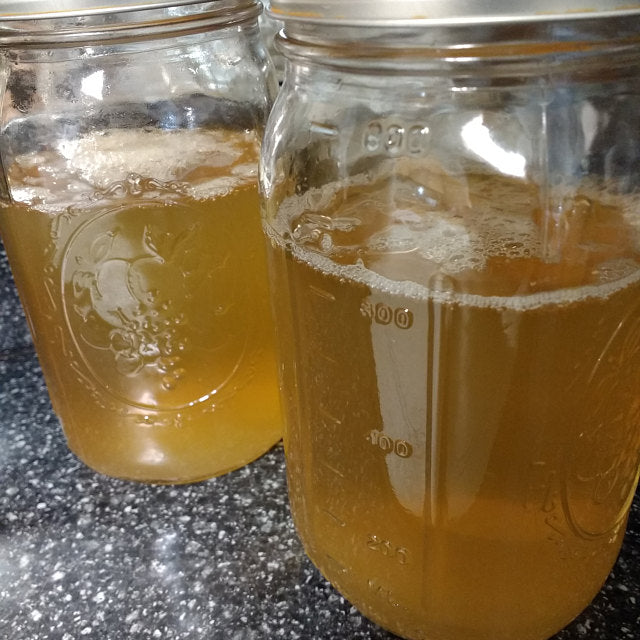
When it comes to water kefir or ginger beer, most people prefer it fizzy. It adds dimension, taste and fun to a healthy beverage. For those who just have to have that fizz, here’s our guide to getting the most fizz out of your fermented beverage:
Everyone talks about 2nd ferments when it comes to carbonation, but the real key to getting good carbonation is a strong first ferment. If your first ferment is weak, you will likely have trouble getting significant fizz no matter what you do during the 2nd ferment. If its still really sweet after 48 hours, you will have a hard time getting that delicious multidimensional flavor or much carbonation during the 2nd ferment or storage. Carbonation tends to kick into gear only when the yeast is strong and the sugar content is low.
- Minerals in the sugar, Minerals in the water.
Yeast is what creates the carbonation. The stronger the yeast, the stronger the fizz. Yeast loves minerals, so make sure to do a mineral rich ferment with at-least 50% of a dark mineral sugar. Try a spoonful of molasses to really get that yeast happy. Also, minerals in the water is just as important. Mineral or well water is best. If you have to use filtered water or your water is really soft, then add some trace mineral drops or calcium supplements. Boiled egg shells, baking soda, dolomite are good choices.
- Heat

Yeast loves the heat and helps create stronger yeast. Try for the low to mid 70’s for a strong balanced ferment. If its below 70, it can still ferment fine, but it tends to be bacteria rich and sour instead of tangy and fizzy.
1. 2nd Ferment
Now that you have a strong first ferment that’s not very sweet anymore and somewhat tangy, its ready for a 2nd ferment. It may be already slightly fizzy or have very little fizz, either way is okay.
Here are some things you can add during the 2nd ferment (when the grains are out) to really get that carbonation going during:
-
Fruit Juice: Fruit juices are probably the easiest way to get carbonation. Be aware that fruit juices can also create higher levels of alcohol. I recommend grape juice, its delicious and can create a bombs worth amount of carbonation. Apple, pomegranate, cherry, prune juice are also good options. Add a couple ounces and let sit for 1-2 days at room temperature with a lid on. Keep an eye on it though as the carbonation does have the potential to break the jar. Burp the jar or bottle if need be. Chill in the fridge before drinking.
-
Fresh ginger: The yeast will thank you. You can use the juice but blending the ginger with some water and then strain the juice from all the fiber. Another option is to peel the ginger and cut up discs of ginger which you can easily remove before consuming.
-
Organic Lemon, lime or orange peel: Citrus peels can make it fizzy and delicious. Be sure to take them out after a few hours so it doesn’t become bitter though.
- Add a teaspoon or so of fresh sugar: Any sugar can work, but darker sugars tend to work a little better.
3. Swing top bottles
Swing top bottles are a must for those serious about bottling and carbonation. It’s ideal for building carbonation and durable enough to withstand extreme carbonation (although be aware that they can still break). I recommend leaving about a 2 inch head space when bottling the kefir.
5. Airlock or closed lid first ferment
Water kefir can ferment anaerobic (without oxygen) if desired. Traditionally, water kefir was fermented with an open lid, but they can do just as well with a closed lid or airlock system. If you want carbonation / fizz and want to drink it fresh without a 2nd ferment, then this is the best option. If you plan to do a 2nd ferment or a few days of storage in the fridge, then it doesn't really matter that much if you use a open or closed lid.
4. Ginger beer plant
Try the ginger beer plant instead of water kefir grains. Ginger beer tends to be naturally fizzier than water kefir due to the yeast composition, higher mineral needs and longer ferments.
5. Fridge storage
Skip the 2nd ferment and simply store in the fridge. Some of my strongest fizzy ferments are ferments that are simply stored in a closed lid in the fridge for a few days without a 2nd ferment. If you had a strong ferment with plenty of yeast activity, a few days in the fridge will build a significant amount of carbonation without the need to add anything else.
Note: You can combine 2nd ferments and a long fridge storage for even more carbonation.
6. Water Kefir Recipes
Search our favorite water kefir recipes that are balanced for flavor as well as fizz. Most will create an abundant amount of carbonation to satisfy your all fizzy needs.
Summary: Start with a strong first ferment which includes a mineral / nutrient rich recipe as well as mineral rich water. Ferment for 48 hours in the 70-75 degree range. Do a 2nd ferment with a bit of fruit juice or ginger or citric peels or fresh sugar (or a combination). Let sit for 1-2 days. Chill in the fridge and enjoy.





Comments
Nathan Wigginton
Hi, do you have any recommendations on how to keep our Kefir water stable once brewed and bottled? Is storing it in the fridge the best solution? Any other alternate tips would be appreciated. Thanks
November 02, 2019
Yemoos Nourishing Cultures
Hi Benjamin – The most likely reason that it goes flat in the fridge is because the yeast is low or no longer active. If its too warm during the 2nd ferment (which may be due to the heating pad), then the yeast will die off before the bacteria and if the yeast count is too low, then it won’t produce more carbonation in the fridge. Also if it becomes too acidic, then the yeast will suffer and won’t be able to produce carbonation at some point. Try shorter can cooler 2nd ferments or simply try bottling the finished kefir with a bit of sugar or juice and then letting it continue to ferment slowly in the fridge.
October 16, 2019
Benjamin
Hi,
My water kefir often is very fizzy after the second ferment. After it has fermented the first time for 48 hours, I let it sit in a closed jar for 24-48 hours on a heating pad. At that point, it has a great well-spring of bubbles from the bottom. But then when I put it in the fridge, it turns absolutely flat.
Any ideas why this might happen?
Thanks for any advice.
October 16, 2019
Yemoos Nourishing Cultures
Hi Leigh – Supplements rich in calcium are the best to way to supplement low mineral water. That’s why boiled egg shells are a good option. Or for something simpler, you can try a pinch of baking soda or dolomite. Trace minerals or sea salt can help a bit too. Ideally, its best not to have overly filtered water when it comes to water kefir. Water that has never been filtered will usually do better than supplemented filtered water.
September 26, 2019
Leigh Anne
In the past when making WK it has always tasted like dead yeast. I have always followed the recipe by CFH I have hard well water but it’s filtered through a system that removes our high manganese in our water. I have put egg shell in to help with low mineral level if I have it. Any suggestions?
September 16, 2019
Yemoos Nourishing Cultures
Hi Laura – It’s possible it may have been exposed to too much heat. Yeast is pretty frail when it comes to summer temperatures. If it was exposed to high temperatures in transit or at home, the yeast may be low which causes low activity. The yeast should fully recover but it can take several batches. Try a spoonful of molasses to help and avoid any temperatures over 80.
August 03, 2019
Laura
Hi! I’ve been making water kefir with the same water, same sugar and the batch is from the same vegan place I always get the grains from. I have always had success until this week. There is nothing going on. After 2 days, no bubbles, no fizz, just plain sugar water. I thought I could do no wrong. The grains look pearly and full. There is no bad smell.
I’m trying now with a few egg shells in one batch and a pinch of baking soda in the other. But as I said, everything is the e grains I’m using now are new, but from the same place I’ve gotten from before (as I mentioned). What do you think could be the problem?
July 26, 2019
Yemoos Nourishing Cultures
Hi Alexe – Thick syrupy water kefir is not too common, but it tends to happen under two circumstances, when there’s too many minerals and/or its too cold. Try using less mineral rich sugars and more lighter / white sugars. Also try to find a warmer spot if possible.
April 30, 2019
Alixe Tayler
Hi, I was wondering if you have any advice on syrupy water kefir. I seem to have a problem with every batch I make. Out of 5 bottles at least 1 to 2 bottles are syrupy….this is on the first fermentation. I’ve tried using less sugar and more scobys but nothing seems to work. Any help would greatly be appreciated!
April 30, 2019
Yemoos Nourishing Cultures
Katie – Nothing bad will happen if you do a 2nd ferment with an open lid. You just won’t get as much carbonation as some of it will escape. But you can also just use a closed jar (not the swing top bottles). Those jars are not as strong as the flip top / swing top bottles so you run a greater risk of them breaking, especially if you are doing a room temperature 2nd ferment. If concerned, just pop the lid once in a while and it should be fine.
March 17, 2019
Leave a comment